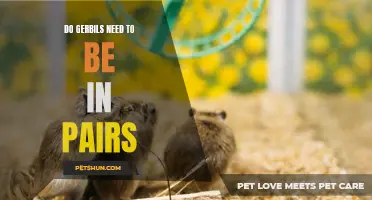
Gerbils are small, energetic, and sociable creatures, making them popular pets for both children and adults. However, owning a gerbil comes with the responsibility of providing them with the proper care and environment they need to thrive. From a well-sized cage to a balanced diet, there are several essential elements that gerbils require to live a happy and healthy life. So, if you're considering bringing a gerbil into your home, it's important to understand what they need to ensure their well-being and to give them the best possible quality of life.
| Characteristics | Values |
|---|---|
| Species | Gerbil |
| Lifespan | 2-4 years |
| Size | 4-5 inches long |
| Diet | Omnivorous, includes seeds, fruits, vegetables, and occasional insects |
| Housing | Glass or plastic tank with bedding and toys |
| Exercise | Large running wheel and time outside of the cage |
| Socialization | Prefer to live in pairs or small groups |
| Temperature | 65-80°F |
| Hygiene | Regular cleaning of cage and bathing in sand bath |
| Health care | Regular check-ups, vaccinations, and proper nutrition |
| Lifespan | 2-4 years |
| Size | 4-5 inches long |
| Diet | Omnivorous, includes seeds, fruits, vegetables, and occasional insects |
| Housing | Glass or plastic tank with bedding and toys |
| Exercise | Large running wheel and time outside of the cage |
| Socialization | Prefer to live in pairs or small groups |
| Temperature | 65-80°F |
| Hygiene | Regular cleaning of cage and bathing in sand bath |
| Health care | Regular check-ups, vaccinations, and proper nutrition |
What You'll Learn
- What do gerbils need in terms of housing and cage size?
- What type of bedding is suitable for gerbils and how often should it be changed?
- What do gerbils need in terms of diet and nutrition?
- What type of exercise do gerbils need and how often should they be allowed to explore outside of their cage?
- What are the social and environmental needs of gerbils, such as companionship and enrichment?

What do gerbils need in terms of housing and cage size?
Gerbils are small, active rodents that make popular pets for many people. When it comes to housing and cage size, gerbils have specific requirements to ensure their well-being. Providing the right environment for your gerbil's housing is essential for their physical and mental health.
In terms of housing, gerbils need a cage that is specifically designed for their needs. The cage should be made of wire mesh or metal bars to ensure proper ventilation and to prevent the gerbils from escaping. A solid bottom is also important to prevent injuries to their feet. Gerbils are natural burrowers, so a deep base is necessary to allow them to dig and create tunnels. The recommended depth for the base of the cage should be at least 10-12 inches.
In addition to the size of the base, the overall dimensions of the cage are important. The cage should be spacious enough to allow the gerbils to move around freely and engage in their natural behaviors. The minimum recommended size for a gerbil cage is 20 inches long by 12 inches wide by 12 inches high. However, bigger is always better when it comes to gerbil cages. Providing more space allows the gerbils to have more room for exercise and exploration.
It is also recommended to provide multiple levels or platforms within the cage to allow the gerbils to climb and explore different areas. Adding tunnels, hides, and other toys can provide enrichment and stimulate their natural instincts.
When considering the location for your gerbil's cage, it is important to choose a spot that is away from direct sunlight, drafts, and excessive noise. Gerbils are sensitive to temperature changes and should be kept in a room that is between 65-75 degrees Fahrenheit. Placing the cage on a stable surface, such as a sturdy table or stand, is also important to ensure that it doesn't tip over or be knocked over by other pets or small children.
Regular cleaning of the gerbil cage is also necessary to maintain a healthy environment for your pet. Gerbils are clean animals, and a dirty cage can lead to health problems. Spot cleaning the cage daily and doing a deep clean at least once a week, including replacing the bedding, is essential. The type of bedding used in the cage is also important, as some types can be harmful to gerbils. Avoid cedar and pine bedding, which can release harmful fumes. Opt for bedding made from paper or aspen instead.
To summarize, gerbils require a spacious and properly designed cage to meet their housing needs. The cage should have a deep base, wire mesh or metal bars for ventilation, and a solid bottom to prevent injuries. The minimum recommended size for a gerbil cage is 20 inches long by 12 inches wide by 12 inches high, but bigger is always better. Providing multiple levels and platforms, along with toys and enrichment items, can help promote mental stimulation and physical exercise. Additionally, placing the cage in a suitable location and ensuring regular cleaning and bedding maintenance are important for the overall health and well-being of gerbils.
The Appearance and Characteristics of a Gerbil: A Small and Curious Rodent
You may want to see also

What type of bedding is suitable for gerbils and how often should it be changed?
Gerbils are small, active rodents that make great pets. Providing them with a comfortable and clean bedding is essential for their well-being. In this article, we will discuss the different types of bedding suitable for gerbils and how often it should be changed.
When selecting bedding for your gerbils, it is important to choose options that are safe and comfortable for them. Avoid using cedar or pine shavings as they can emit harmful chemicals and cause respiratory issues. Instead, opt for bedding made from paper, aspen shavings, or hay.
Paper bedding is a popular choice for gerbil owners. It is highly absorbent, odor-absorbing, and soft. It is made from recycled paper and is safe for gerbils to burrow and nest in. Another option is aspen shavings, which are also absorbent and provide a natural, comfortable surface for gerbils to walk and play on. Hay can be used as a bedding too, as it provides a soft and natural environment for gerbils.
The frequency of bedding change depends on the type of bedding you are using, the number of gerbils you have, and their habits. Generally, it is recommended to clean the bedding once a week. However, if you notice a strong odor or the bedding is soiled, it may need to be changed more frequently. Additionally, spot-cleaning the bedding by removing any wet or soiled areas on a daily basis is important to maintain a clean living environment for your gerbils.
Here is a step-by-step guide on how to change the bedding for your gerbils:
- Prepare a new batch of fresh bedding by pouring the desired amount into the cage.
- Carefully remove the gerbils from the cage and place them in a secure and temporary enclosure.
- Remove all accessories, such as toys and food bowls, from the cage.
- Scoop out the old bedding using a dustpan and brush or a small shovel. Be careful not to disturb the gerbil's burrows or nests.
- Wipe down the cage walls and floor with a pet-safe disinfectant to remove any remaining dirt or odor.
- Allow the cage to dry completely before adding fresh bedding.
- Place the cleaned accessories back into the cage.
- Gently transfer the gerbils back into their newly cleaned home.
- Make sure to wash your hands thoroughly after handling the old bedding.
It is also important to monitor the temperature and humidity levels in the gerbil's living environment. Gerbils are sensitive to extreme conditions, so ensure that the bedding remains dry and the cage is kept at a moderate temperature.
In conclusion, selecting the right bedding for your gerbils and maintaining a clean living environment is crucial for their health and well-being. Opt for safe options such as paper bedding, aspen shavings, or hay, and change the bedding regularly, based on the level of soiling and odor. Following the step-by-step guide provided will help ensure a comfortable and clean habitat for your beloved gerbils.
The Perfect Number of Gerbils to Keep Together for a Happy and Harmonious Home
You may want to see also

What do gerbils need in terms of diet and nutrition?
Gerbils are small rodents that are kept as popular pets. In order to ensure the health and well-being of your gerbil, it is important to provide them with a proper diet and nutrition. Gerbils are omnivorous, which means that they eat both plant and animal matter. Their diet consists primarily of grains, seeds, fruits, vegetables, and small insects.
A balanced diet for gerbils should consist of a commercial gerbil food mix, as well as appropriate fresh foods. Commercial gerbil food mixes can be found at most pet stores and are specifically formulated to meet the nutritional needs of gerbils. These mixes often contain a combination of grains, seeds, and dried fruits and vegetables. It is important to check the ingredients list to ensure that the mix does not contain any harmful additives or preservatives.
In addition to their commercial food mix, gerbils should also be given fresh foods as part of their daily diet. Fresh fruits and vegetables are excellent additions to a gerbil's diet. Some examples include carrots, spinach, apples, and bananas. These foods provide essential vitamins and minerals that are necessary for a gerbil's overall health. It is important to introduce new foods gradually, as sudden changes in diet can upset a gerbil's digestive system.
Protein is also an important component of a gerbil's diet. In the wild, gerbils consume insects and other small animals as a source of protein. As a pet owner, you can replicate this natural diet by providing your gerbil with small amounts of high-quality protein sources. Examples include mealworms, crickets, and small amounts of cooked chicken or egg. It is important to note that too much protein can be harmful to a gerbil's health, so it should be given in moderation.
In addition to a balanced diet, gerbils also need access to fresh water at all times. A gerbil's water should be changed daily to ensure cleanliness. Water can be provided through a small water bottle or a shallow dish. It is important to monitor the water level regularly to ensure that your gerbil has an adequate supply.
In summary, gerbils require a balanced diet that consists of a commercial gerbil food mix, fresh fruits and vegetables, and small amounts of protein. It is important to provide access to fresh water at all times and to monitor your gerbil's diet to ensure their health and well-being. By providing a proper diet and nutrition, you can help to ensure that your gerbil lives a happy and healthy life.
Are Gerbils Smart? Uncovering the Intelligence of these Small Pets
You may want to see also

What type of exercise do gerbils need and how often should they be allowed to explore outside of their cage?
Gerbils are small, active rodents that require regular exercise to stay healthy and happy. In the wild, they would spend their days exploring and foraging for food, so it's essential to provide them with opportunities for physical activity in captivity as well. In this article, we will discuss the type of exercise gerbils need and how often they should be allowed to explore outside of their cage.
Gerbils are naturally curious and energetic creatures. They possess a strong instinct to burrow, dig, and climb. To accommodate these behaviors and ensure their well-being, it's crucial to provide them with an appropriately sized and designed enclosure. A gerbil cage should offer ample space for them to run, tunnel, and climb, with multiple levels and hiding spots to encourage their natural behaviors.
Exercise wheels are a popular and effective form of exercise for gerbils. These small rodents love to run, and a wheel allows them to get the physical activity they need in a confined space. When choosing a wheel, make sure it is specifically designed for gerbils and has a solid running surface, as wire mesh can cause foot injuries.
Besides exercise wheels, it's important to provide other forms of mental and physical stimulation for gerbils. You can do this by providing them with tunnels, tubes, and platforms inside their cage. These enrichments not only provide exercise opportunities but also keep them mentally stimulated by encouraging exploration and problem-solving.
In addition to in-cage exercise, gerbils should also be given the opportunity to explore outside of their cage. This allows them to experience new sights, sounds, and smells, which are essential for their overall well-being. However, it's vital to ensure their safety while they are outside of their enclosure.
When allowing gerbils to explore outside of their cage, it's important to create a safe and secure environment. You can do this by setting up a gerbil-proofed play area. Make sure the area is escape-proof, free of hazards, and doesn't contain any toxic substances. Cover any small openings or gaps where they might escape or get stuck. It's essential to supervise them closely during their playtime to prevent accidents or injuries.
The frequency and duration of outside-of-cage exploration for gerbils depend on their personality and energy level. As a general guideline, gerbils should be given at least 30 minutes of supervised playtime outside of their enclosure per day. However, some gerbils may prefer longer sessions, while others may be content with shorter periods. It's essential to observe your gerbil's behavior and adjust their playtime accordingly.
In conclusion, gerbils need regular exercise to stay healthy and happy. They have a natural instinct to burrow, dig, and climb, so it's important to provide them with an appropriately designed cage that allows for these behaviors. Exercise wheels, tunnels, and platforms are great additions to their enclosure to provide mental and physical stimulation. Additionally, gerbils should be allowed to explore outside of their cage in a safe and supervised manner. Providing them with 30 minutes of playtime per day is a good starting point, but it's important to observe their behavior and adjust accordingly. By providing them with the exercise and enrichment they need, you can ensure that your gerbil lives a happy and fulfilling life.
The Basics of Breeding Gerbils: A Guide to Successful Gerbil Reproduction
You may want to see also

What are the social and environmental needs of gerbils, such as companionship and enrichment?
Gerbils are small animals that belong to the rodent family. They are often kept as pets due to their small size and friendly nature. However, it is important to understand the social and environmental needs of gerbils in order to provide them with a happy and healthy living environment.
Companionship is an important aspect of a gerbil's social needs. Gerbils are social animals and they thrive when they have the company of other gerbils. It is recommended to keep gerbils in pairs or small groups of the same sex. However, it is crucial to introduce gerbils slowly and carefully to ensure that they get along. Introducing gerbils of different age groups or unfamiliar gerbils may lead to aggression and fighting.
Enrichment is another crucial aspect of a gerbil's environmental needs. Gerbils are active animals that need mental stimulation and physical activity. Providing them with a variety of toys and accessories in their enclosure can help keep them entertained and prevent boredom. Some examples of enrichment items for gerbils include tunnels, chew toys, exercise wheels, and hiding spots. It is important to regularly rotate and introduce new toys to keep them engaged.
Creating a suitable living environment for gerbils involves replicating their natural habitat as closely as possible. Gerbils are desert-dwelling rodents, so their enclosure should have a substrate that mimics the sandy desert floor. A deep layer of bedding material such as aspen shavings or paper bedding will allow gerbils to burrow and create tunnels, which is a natural behavior for them.
In addition, gerbils need a well-ventilated enclosure with proper temperature and humidity levels. It is important to keep the enclosure away from direct sunlight and drafts. The temperature should be maintained at around 65-75°F (18-24°C) and the humidity level should be around 40-60%.
Gerbils also require a balanced diet to meet their nutritional needs. A commercial gerbil food mix can serve as the base of their diet, but it should be supplemented with fresh vegetables, fruits, and occasional treats. It is important to provide fresh water at all times and monitor their food intake to prevent obesity.
Providing a suitable living environment for gerbils not only meets their social and environmental needs, but it also promotes their overall health and well-being. By understanding and catering to these needs, gerbil owners can ensure that their pets live a happy and fulfilling life.
Why Do Gerbils Shed Their Tails? Understanding the Phenomenon
You may want to see also
Frequently asked questions
Gerbils need a suitable and spacious habitat that includes a minimum of 10 gallons of space per gerbil. They also need bedding material such as aspen shavings or shredded paper for burrowing and nesting. Additionally, their habitat should include a small house or hiding spot, a wheel for exercise, and toys or tunnels for enrichment.
Gerbils require a balanced diet that consists mainly of high-quality gerbil pellets, which provide essential nutrients and a source of fiber. They should also be given small amounts of fresh vegetables and occasional treats, such as fruits or seeds. Fresh water should always be available to them in a water bottle or dish.
Yes, gerbils are social animals and should be kept in same-sex pairs or small groups to prevent loneliness and boredom. They thrive when they have a companion to interact with and groom. It is important to introduce gerbils properly and ensure they get along before housing them together.
Gerbils are active animals that need regular exercise to stay healthy. They should have access to a safe exercise wheel or other toys that encourage physical activity. It is best to let them out of their cage for supervised playtime outside their habitat for at least an hour each day.
Gerbils have continuously growing teeth, so it is important to provide them with suitable chewing material to prevent overgrowth and dental issues. This can be done by giving them wooden chew toys, untreated fruit tree branches, or mineral blocks. Regular veterinary check-ups are also recommended to ensure their teeth are in good health.







